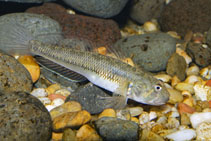| Family: |
Gobiidae (Gobies), subfamily: Gobionellinae |
| Max. size: |
11.43 cm SL (male/unsexed) |
| Environment: |
demersal; freshwater; brackish |
| Distribution: |
Oceania: high islands of Hawaii. |
| Diagnosis: |
Dorsal spines (total): 7-7; Dorsal soft rays (total): 10-11; Anal spines: 1-1; Anal soft rays: 10-11. Easily identified by the dark black bar extending downward through the eye and the yellow-brown body color; during courtship, both males and females with 9-11 black bars on their flanks and a red border on the edge of the dorsal fins; black eye bar becomes prominent; males develop a dusky flush to their throats and lower jaw (Ref. 44091).
Largest Insularigobius recorded; possesses a relatively high scale count in horizontal series, 47-52, usually 48-50; high predorsal scale count, always fully scaled, 16-23, usually 19-20; belly anteriorly almost always scaled close to pelvic base; breast always with many embedded scales; up to five rows of teeth in upper jaw and up to six in lower jaw (Ref. 34009). |
| Biology: |
A poor climber and thus restricted to the lower reaches and adjoining brackish waters; found in both altered and unaltered streams; omnivorous and a benthic feeder on filamentous algae, worms, crustaceans and insect larvae; not highly sought as food by the early Hawaiians (Ref. 44091). Benthic (Ref. 58302). |
| IUCN Red List Status: |
Not Evaluated (N.E.) Ref. (130435)
|
| Threat to humans: |
harmless |
Source and more info: www.fishbase.org. For personal, classroom, and other internal use only. Not for publication.
